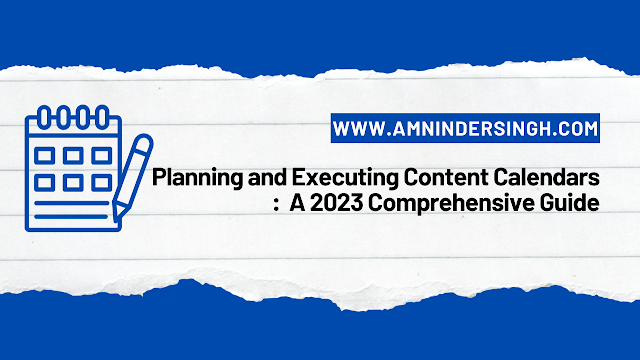In the world of digital marketing and content creation, consistency is key. One of the most effective tools for maintaining consistency in your content strategy is a well-structured content calendar.
A content calendar helps you plan, organize, and execute your content marketing efforts efficiently.
In this guide, we will walk you through the process of planning and executing a content calendar that aligns with your business goals and engages your target audience effectively.
Understanding Content Calendars
1.1 What is a Content Calendar?
A content calendar is a strategic tool that outlines your content marketing strategy over a specific period. It serves as a visual roadmap, helping you schedule and manage the creation, publication, and promotion of content, such as blog posts, social media updates, videos, and emails.
1.2 Why Do You Need a Content Calendar?
Consistency: A content calendar ensures that you consistently produce and share content, which is crucial for maintaining audience engagement.
Efficiency: It helps streamline your content creation process, making it more organized and efficient.
Goal Alignment: Content calendars can be aligned with your marketing and business goals, ensuring that your content serves a purpose.
Collaboration: Teams can collaborate more effectively when they have a clear content plan.
Planning Your Content Calendar
2.1 Define Your Goals
Start by establishing clear and measurable content marketing goals. These goals could include increasing website traffic, generating leads, boosting brand awareness, or engaging with your audience on social media. Your content calendar should be designed to support these objectives.
2.2 Know Your Audience
Understand your target audience’s preferences, pain points, and interests. This knowledge will inform the type of content you create and when you publish it to maximize engagement.
2.3 Content Types and Channels
Identify the types of content you want to create (e.g., blog posts, videos, infographics) and the channels you’ll use to distribute them (e.g., website, social media, email).
2.4 Keyword Research
For SEO-driven content, conduct keyword research to identify relevant keywords and topics that align with your goals and resonate with your audience.
2.5 Content Topics and Themes
Brainstorm content ideas and themes that relate to your business, industry trends, and your audience’s interests. These ideas will serve as the foundation for your content calendar.
2.6 Content Calendar Structure
Determine the timeframe for your content calendar. It can be weekly, monthly, quarterly, or even yearly. Ensure it includes important dates, holidays, and industry events relevant to your content.
Creating Your Content Calendar
3.1 Choose a Content Calendar Tool
Select a tool to create and manage your content calendar. Popular options include Google Calendar, Trello, Asana, and dedicated content calendar software like CoSchedule or Airtable.
3.2 Set Publishing Dates and Times
Determine when your content will be published. Consider your audience’s time zones and the best times to post on each platform.
3.3 Assign Responsibilities
Assign tasks and responsibilities to team members or contributors. Clearly define who will write, design, edit, and promote each piece of content.
3.4 Content Creation Workflow
Create a workflow that outlines the content creation process, from ideation and research to drafting, editing, and final publication.
3.5 Review and Approval Process
Establish a review and approval process to ensure content meets quality standards and aligns with your brand’s voice and style.
Executing Your Content Calendar
4.1 Content Creation
Begin creating your content according to the schedule outlined in your calendar. Follow your workflow, and involve relevant team members in the process.
4.2 Quality Control
Thoroughly review and edit content to maintain quality. Ensure it’s error-free, engaging, and aligns with your goals.
4.3 Publication and Promotion
Publish content on the scheduled dates and times. Promote it across your chosen channels, utilizing relevant hashtags, keywords, and social media strategies.
4.4 Engagement and Monitoring
Engage with your audience by responding to comments and messages promptly. Monitor content performance using analytics tools to assess what’s working and what needs improvement.
Content Calendar Maintenance
5.1 Flexibility
Be adaptable. If unexpected events or trends arise, adjust your content calendar to stay relevant and timely.
5.2 Regular Updates
Review and update your content calendar regularly to reflect evolving goals, audience feedback, and industry changes.
5.3 Content Recycling
Don’t let valuable content go to waste. Consider repurposing and recycling evergreen content to extend its shelf life.
Measuring Success
6.1 Key Performance Indicators (KPIs)
Measure the success of your content marketing efforts using KPIs relevant to your goals, such as website traffic, conversion rates, social media engagement, or email open rates.
6.2 Analytics Tools
Utilize analytics tools like Google Analytics, social media insights, and email marketing analytics to track and analyze performance.
Planning and Executing Content Calendars : Conclusion
A well-planned and executed content calendar is a fundamental tool for any successful content marketing strategy.
It ensures consistency, goal alignment, and efficiency in your content creation and distribution efforts.
By following the steps outlined in this guide, you can create and maintain a content calendar that drives results and helps you connect with your target audience effectively.
Remember that content calendars are adaptable, so refine your strategy over time to continually improve your content marketing efforts.
This article is a part of our content marketing module.
Module 5: Content Marketing
5.1 The Art of Devising a Comprehensive Content Strategy
5.2 Crafting Engaging and Diverse Content Formats
5.3 Planning and Executing Content Calendars
5.4 Amplifying Content Reach and Impact
5.5 Evaluating Content Performance

